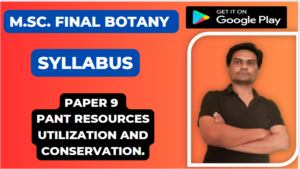![]()
RRBMU
Syllabus M.Sc. Final. Botany
Scheme – Each paper have 9 questions, out of which a student has to attempt 5 questions including the question No.1 witch will be compulsory. The question No.1 will carry 20marks and will be of several short objective type questions such as multiple choice type, one liner answer type, one word type and fill in the blanks types.
Paper 7 – Plant morphology, development anatomy and reproductive biology
Unit 1
Introduction: Unique feature of plant development, differences between animal and plant development.
Seed germination and seedling growth; Metabolism of proteins and mobilization of food reserves, tropisms during seed germination and seedling growth, hormonal control of seedling growth, gene expression use of mutants in understanding seedling development.
Soot development: Organization of the shoot apical meristem (SAM) cytological and molecular analysis of SAM, control of cell division and cell to cell communication, Primary and secondary tissue differentiation, control of tissue differentiation, especially xylem and phloem, secretory ducts and laticifers, wood development in relation to environmental facrors.
Unit 2
Leaf growth and differentiation, Inception, phyllotaxy, control of leaf form (Leaf meristems and other factors), differentiation of epidermis (with special reference to stomata and trichomes) and mesophyll, kranz anatomy, Leaf traces and leaf gaps, transfer cells.
Root development: Organization of root apical meristem (RAM) vascular tissue differentiation lateral roots, root hairs, root microbe interactions.
Seed coat development: External and internal morphology of sed, seed appendages, ontogeny of seed coat in various families, mature structures, spermoderm patterns.
Unit 3
Reproduction: Vegetative options and sexual reproduction, flower development genetics of floral organ differentiation, homeotic mutants in Arabidopsis and Antirhinum, sex determination.
Male Gametophyte : Structure of anthers, microsporogenesis, role of tapetum pollen development and gene expression, male sterility, sperm dimorphism and hybrid seed production, pollen germination, pollen tube growth and guidance, pollen storage, pollen allergy, pollen embryos.
Female Gametophyte ; Ovule development, megasporogenesis, organization of the embryo sac, structure of the embryo sac cells.
Pollination, pollen- pistil interaction and fertilization; Floral characteristics, pollination mechanism and vectors, structure of the pistil, pollen stigma interactions, sporophytic and gametophytic self incompatibility (cytological, biochemical and molecular aspects) double fertilization in vitro fertilization.
Unit 4
Seed development and fruit growth: Endosperm development, embryogenesis, cell lineages during late embryo development, storage proteins of endosperm and embryo.
Polyembryony, apomixis, embryo culture, dynamics of fruit growth, biochemistry and molecular biology of fruit maturation.
Latent life – dormancy importance and type of dormancy, seed dormancy, overcoming seed dormancy bud dormancy.
Senescence and programmed cell death (PCD) Basic concept types of cell death PCD in the life cycle of plants, metabolic changes associated with senescence and its regulation, influence of hormones and environmental factors on senescence.



